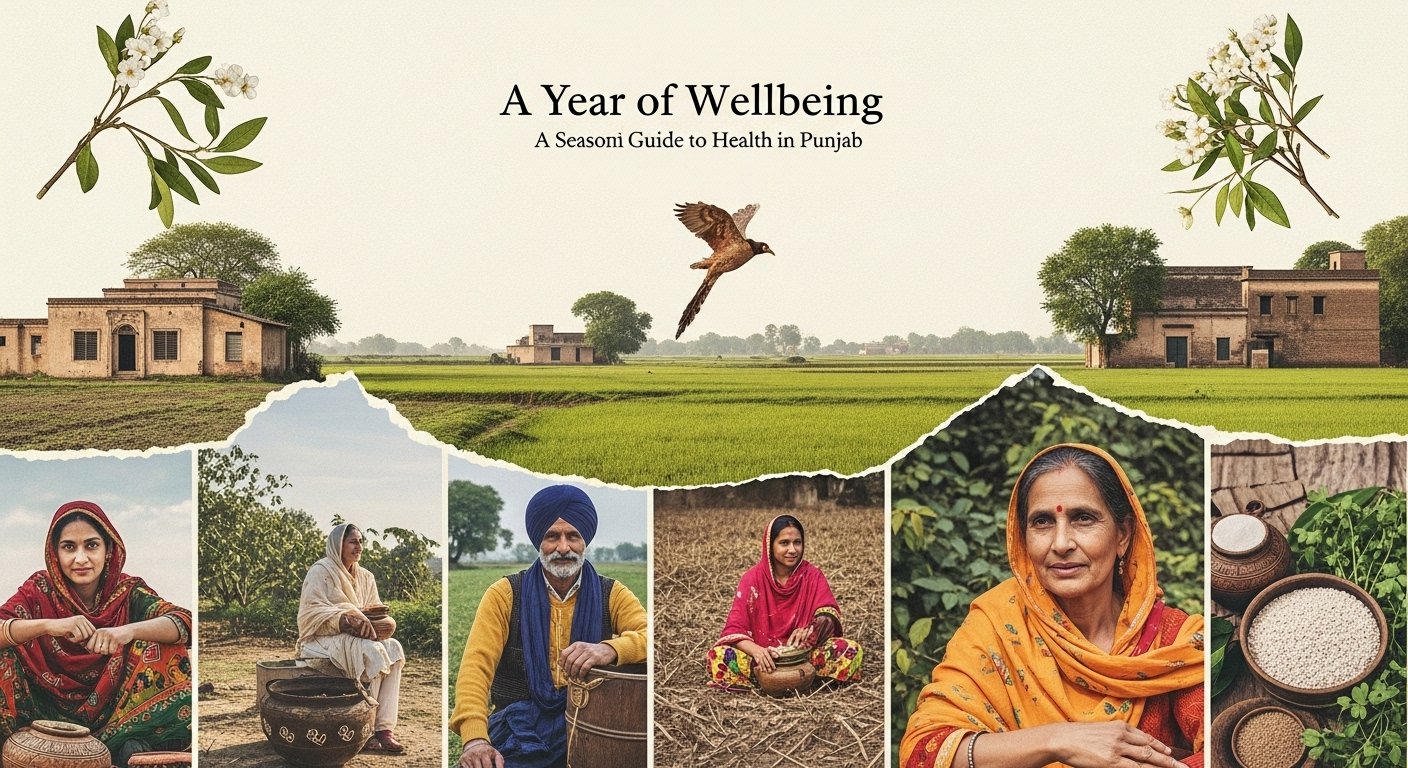In the heart of Punjab, life is lived in vibrant, distinct seasons. We feel the fierce embrace of the summer sun, hear the life-giving drum of the monsoon rains, see the world soften in the winter fog, and celebrate the explosion of color in the spring. Our health, too, is not a static condition; it is a dynamic dance with this powerful rhythm of nature. To be truly healthy in a place like Sangla Hill in 2025 is to understand and adapt to the unique challenges and opportunities that each season brings.
This is a seasonal guide to wellbeing, a practical approach to navigating the year in Punjab, ensuring that our bodies and minds remain resilient, harmonious, and strong through every cycle.
The Summer Scorch & Monsoon Relief (May – August)
The Challenge: This is a season of extremes. The scorching heat from May to July brings the risk of dehydration and heatstroke, followed by the monsoon, which, while offering relief, ushers in a new set of challenges with humidity, water-borne illnesses, and mosquito-borne diseases.
Your Health Strategy:
- Hydrate Relentlessly: This is your single most important task. Water is essential, but you also lose vital salts through sweat. Supplement your water intake with traditional, natural cooling drinks. A glass of salty lassi or a freshly squeezed lemon and mint drink (sikanjabeen) replenishes both fluids and electrolytes far better than sugary sodas, which can worsen dehydration.
- Eat Light and Cool: Your digestive system slows down in extreme heat. Favour light, water-rich foods. This is the season for watermelon (tarbooz), melons (kharbooza), cucumbers (kheera), and fresh salads. Avoid heavy, oily, and overly spicy meals that are hard to digest and increase body heat.
- Time Your Activity: All strenuous physical activity, including walking or playing sports, must be shifted to the coolest parts of the day—either at dawn, before the sun gains strength, or late in the evening, after it has set.
- Monsoon Vigilance: As the rains arrive, so does the risk of disease. Dengue fever, spread by mosquitoes, becomes a major threat. Ensure there is no standing water around your home where mosquitoes can breed. To prevent water-borne illnesses like typhoid and hepatitis, drinking boiled or properly filtered water is non-negotiable. Be extra cautious with food from outside vendors during this time.
The Gentle Autumn (September – October)
The Challenge: There are few challenges in this beautiful, temperate season. The primary opportunity is to recover from the stress of summer and build a strong foundation of health for the coming winter.
Your Health Strategy:
- Embrace the Harvest: Autumn brings a bounty of fresh vegetables to the market. This is the perfect time to load your diet with a variety of nutrient-rich foods. Establish a routine of balanced, wholesome meals to strengthen your immune system.
- Maximize Outdoor Activity: The weather is ideal. This is the best time of year for outdoor exercise. Start a daily walking routine, enjoy family cricket matches in the park, or simply spend more time outdoors. Building your cardiovascular fitness now will serve you well during the more sedentary winter months.
- Preventative Check-ups: With the harshness of summer past and the illnesses of winter ahead, autumn is an excellent time for annual health check-ups. Consider getting the seasonal flu vaccine to provide an extra layer of protection before the winter virus season begins.
The Winter Chill & Fog (November – January)
The Challenge: Winter in Punjab brings its own set of significant health risks. The arrival of thick smog leads to a sharp increase in respiratory problems, while the cold, grey days can lead to a more sedentary lifestyle and a dip in mental wellbeing.
Your Health Strategy:
- Protect Your Lungs: The winter smog is a serious health hazard. Monitor the Air Quality Index (AQI) daily. On days with poor air quality, limit time outdoors, especially for children and the elderly. If you must go out, wearing a good quality mask (N95 or KN95) can significantly reduce the intake of harmful pollutants. The health risk in winter can be seen as a function of multiple factors:Rwinter∝(AQI+Vload)Where the risk (Rwinter) is proportional to the Air Quality Index (AQI) combined with the circulating viral load (Vload) for illnesses like the flu.
- Nourish with Warmth: This is the season for warm, comforting, and nutrient-dense foods. Embrace winter staples like mustard greens (sarson ka saag), root vegetables, and hearty soups. It is also the season for Punjab’s famous citrus fruits, especially oranges (kinnows), which are packed with immune-boosting Vitamin C. Nuts and seeds are excellent sources of healthy fats and energy.
- Stay Active Indoors: The cold and fog can make outdoor exercise difficult. It is vital to find ways to keep moving. Simple home-based exercises, yoga, and stretching can maintain muscle tone and circulation.
- Mind Your Mood: The shorter days and lack of sunlight can affect mood and energy levels. Make an effort to get some sunlight during the middle of the day whenever possible. Maintain your social connections, as isolation can worsen feelings of winter blues.
The Vibrant Spring (February – April)
The Challenge: Spring is a glorious season of renewal and pleasant weather. For many, however, it is also the peak season for pollen and seasonal allergies.
Your Health Strategy:
- Eat Fresh and Light: As new vegetables and greens arrive in the market, shift your diet away from the heavier foods of winter. Spring is an ideal time for a “reset,” focusing on fresh salads, lean proteins, and hydrating foods.
- Enjoy the Outdoors, Cautiously: Continue the outdoor activity routines established in autumn. However, if you are prone to seasonal allergies, be mindful of high pollen counts. On windy days, it may be wise to exercise indoors. Keeping windows closed at home can help reduce exposure to pollen.
- Manage Allergies: For those who suffer from spring allergies, simple measures like saline nasal rinses can be effective. Traditional remedies may also provide relief. If symptoms are severe, consult a doctor, as effective antihistamines are readily available.
Conclusion: Living in Harmony
Health is not a destination to be arrived at, but a continuous journey of adaptation. By understanding the unique rhythm of the seasons in Punjab, we can move from a reactive state of treating illness to a proactive state of cultivating wellbeing. This knowledge is a form of empowerment. It allows us to anticipate the challenges and embrace the opportunities that each part of the year presents. Living in harmony with our environment is the oldest form of wisdom, and it is the most effective strategy for building a life of resilience, vitality, and health in the land we call home.



